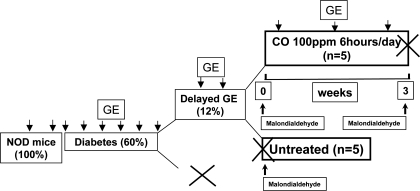Fig. 1.
Cartoon of experimental plan for carbon monoxide (CO) treatment. Eight-week-old female nonobese diabetic (NOD)/ShiLtJ mice were received from Jackson laboratory, and 2 baseline gastric emptying readings were obtained for each mouse before development of diabetes. After onset of diabetes, gastric emptying (GE) was measured every week. Mice were considered to have delayed gastric emptying if two consecutive gastric emptying t1/2 values were greater than normal. Diabetic mice with delayed gastric emptying were assigned to 2 groups; one group (n = 5) was killed, and serum and gastric tissue was collected. The other group (n = 5) was assigned to receive CO inhalation 100 ppm for 6 h/day for a maximum period of 8 wk or less if the mouse had 2 consecutive normal gastric emptying t1/2. At the end of this period, mice were killed and gastric tissue and serum was collected.

